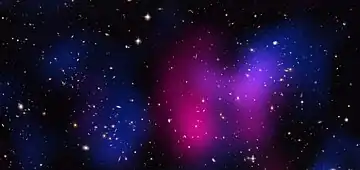Musket Ball Cluster
The Musket Ball Cluster (DLSCL J0916.2+2951) is a galaxy cluster that exhibits separation between its baryonic matter and dark matter components. The cluster is a recent merger of two galaxy clusters. It is named after the Bullet Cluster, as it is a slower collision, and older than the Bullet Cluster. This cluster is further along the process of merger than the Bullet Cluster,[3] being some 500 million years older, at 700 million years old.[4] The cluster was discovered in 2011 by the Deep Lens Survey.[2] As of 2012, it is one of the few galaxy clusters to show separation between its dark matter and baryonic matter components.[5]
| Musket Ball Cluster | |
|---|---|
 | |
| Observation data (Epoch J2000.0[1]) | |
| Constellation(s) | Cancer |
| Right ascension | 09h 16m 10.9s[1] |
| Declination | +29° 48′ 44″[1] |
| Redshift | 0.53[2] |
| Other designations | |
| Musket Ball Cluster,[3] DLSCL J0916.2+2951,[2] SHELS J0916.2+2949[1] | |
Characteristics
As of 2012, it is one of seven galaxy clusters that exhibit separation of dark matter and baryonic matter following cluster collision and merger.[3] The separation between the galaxies and their dark matter components is on average 19,000 light-years (5,800 pc). This separation may indicate that dark matter may interact with itself, through a dark force (a force that only interacts with dark matter) or a set of dark forces.[6] The galaxy cluster itself is some 8 million light-years (2.5 Mpc) across.[7]
See also
- Other dissociative galaxy cluster mergers known at time of discovery
- Bullet Cluster (2006)
- MACS J0025.4-1222 (2008)
- Abell 520 (2007)
- Abell 2744 (2011)
- Abell 2163 (2011)
- Abell 1759 (2011)
References
- "NAME Musket Ball Cluster". SIMBAD. Centre de données astronomiques de Strasbourg. Retrieved 27 July 2014.
- Dawson, William A.; Wittman, David; Jee, M. James; Gee, Perry; Hughes, John P.; Tyson, J. Anthony; et al. (19 October 2011). "Discovery of a Dissociative Galaxy Cluster Merger with Large Physical Separation". The Astrophysical Journal Letters (published March 2012). 747 (2): 6. arXiv:1110.4391. Bibcode:2012ApJ...747L..42D. doi:10.1088/2041-8205/747/2/L42. S2CID 119244278. L42.
- Chandra X-Ray Observatory (12 April 2012). "DLSCL J0916.2+2951: Discovery of the Musket Ball Cluster". Harvard University.
- Mark Brown (13 April 2012). "The Musket Ball Cluster is 500 million years older than the Bullet Cluster". Wired. Archived from the original on 4 March 2015. Retrieved 5 September 2017.
- Will Dawson (6 May 2012). "Constraining Dark Matter with the Musket Ball Cluster". Will Dawson - Cosmology Research.
- Adam Mann (9 January 2013). "Galactic Pile-Up May Point to Mysterious New Dark Force in the Universe". Wired.
- Adam Mann (12 April 2012). "Galactic Collision May Contain Clues About Dark Matter". Wired.
External links
- Chandra X-Ray Observatory: "Musket Ball Cluster in 60 Seconds", April Hobart, 16 April 2012 (PODcast)
